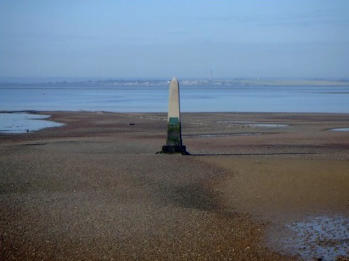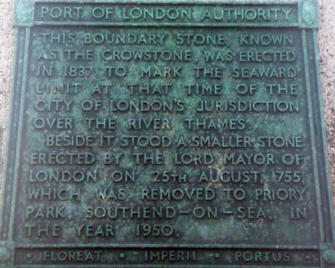The Crowstone
Obelisks,
columns
and
other
such
monoliths
are
apt
to
attract
attention
by
reason
of
their
height
and
the
usually
prominent
position
which
they
occupy
in
the
town,
city
and
countryside.
Many
belong
to
the
eighteenth
and
mid-nineteenth
centuries,
and
their
weathered inscriptions today recall public figures and event of the past.
Standing
tall
and
solitary
on
the
foreshore
at
Westcliff-on-Sea,
the
Crowstone
is
an
obelisk
with
a
difference.
Uncommonly
situated,
its
very
presence
demands
explanation.
To
approach
at
high
tide,
however,
one
must
either
take
boat
or
swim.
Alternatively,
one
may
wade
across
at
a
later
hour
or,
if
not
suitable
shod,
patiently
await
a
reasonably
dry
footing,
since
leather
has
no
liking
for
salt-water
puddles.
Accordingly,
there
are
those
occasions
when
interested
persons
decide
instead
to
view
the
Crowstone
distantly,
from
the
convenience
of
the
promenade,
so that its time-honoured associations remain unappreciated.
Marked Seaward Limit of Thames
The
Crowstone’s
copper
plate
–
now
turned
green
–
records
that
it
was
erected
in
1836
and
marked
the
seaward
limit
of
the
River
Thames
as
then
controlled
by
the
City
of
London,
and
that
it
replaced
a
stone
of
1755,
both
standing
together
until
the
more
aged
of
the
pair
was
presented
by
the
Port
of
London
Authority
to
Southend Corporation in 1950 for preservation in Priory Park.
When
raised
at
Westcliff
210
years
ago
this
stone
(now
retired
in
land)
also
took
the
place
of
an
earlier
limit-mark.
The
Crowstone
stationed
alone
on
the
foreshore
is,
in
fact,
one
of
a
number
to
have
occupied
the
same
site,
or
one
close
by,
and
merits
inspection
in
that
it
bears
testimony
to
London’s
conservancy
of
this
eastward
reach
of
the
Thames
as
exercised
over
a
period
of
almost
seven
centuries.
Long
before
Westcliff
developed,
the
Crowstone
was
officially
recognized
as
the
city
stone
at
Leigh.
Even
so,
in
his
duties
as
the
water
bailiff,
Roger
Griffiths
would
speak
of
the
Crowe’s
stone,
and
in
an
essay
of
1746,
one
of
the
few
references
to
have
survived,
he
stated:
A
little
below
this
island
(Canvey),
or
rather
opposite
to
the
lower
end
of
it,
is
a
small
town
called
Leigh,
of
little
or
no
account
otherwise
than
that
it
is
well
stocked
with
fishermen
and
seamen,
and
likewise
that
about
two
miles
below
this
town
the
jurisdiction
of
London
on
the
Essex
side
of
the
river
terminates
at
a
place
called
Crow
Stone,
where
there
was
a
mark
stone,
but
by
some
accident
it has now been lost for these several years.”
The
stone
now
established
as
a
local
antiquity
at
Priory
Park
was
a
replacement
in
1755
of
that
declared
as
“lost”
–
or
possibly
fallen.
If
so,
and
then
broken
up
to
be
carted
away,
in
all
likelihood
the
same
measures
were
adopted
in
the
disposal
of
previous
stones
when
no
longer
serviceable,
for
little
or
no
information
of
these
is
available.
The
years
of
their
erection
on
the
foreshore and subsequent removal appear to have gone unrecorded.
Formal Rights
Formal
rights
over
restricted
stretches
of
the
Thames
east
and
west
of
London
Bridge
were
first
granted
to
city
conservators
in
1197,
for
the
payment
of
1,500
marks,
by
Richard
I.
Richard’s
document
was
confirmed
by
King
John
in
1199,
by
Henry
III
in
1227
and
by
Edward
I,
whose
charter
of
1285
extended
administration
of
the
river,
the
easterly
limit
being
determined
at
the
Essex
shore.
From
here
the
boundary
reached
across
to
Yantlet
Creek,
by
the Kentish mainland, upon which today is the London stone.
To
honour
Edward’s
charter,
the
numerals
1285
once
appeared
on
the
stone
taken
for
safe
keeping
to
Priory
Park
fifteen
years
ago,
but
the
commemorative
date
is
obliterated
now
except
for
the
figure
“5”
in
itself
so
vague
as
to
be
detected
only
by
a
keen
eye.
The
stone
carries
also
the
City
shield,
with
the
short
sword
of
St
Paul,
London’s
patron
saint,
just
distinguishable.
Scarred
and
bleached,
the
stone
is
very
much
suited
to
its
surroundings,
within a few steps of the entrance to the ancient priory of Prittlewell.
How
the
Crowstone(s)
became
so
called
is
not
accurately
known.
The
name
may
have
arisen
from
a
nearby
tenement
exiting
in
1536
–
Crowes.
The
again
it
has
been
suggested
that
at
one
time
beach-combing
crows,
which
colonized
agricultural
settlements
of
the
district,
favoured
the
stone
as
a
look-out.
That
these
numerous
birds
accounted
in
the
first
instance
fro
the
naming
of
both
the
tenement and stone is sufficiently realistic to be accepted. Beyond this, other reasons advanced have no local connection.
There
are
lively
reports
of
ceremonial
visits
paid
to
the
Crowstone
in
the
1800s,
and
earlier,
by
the
Lord
Mayor
of
London
and
aldermen,
water
bailiffs
and
sheriffs.
Greatly
festive
occasions,
these
took
place
every
seven
years
and
attracted
crowds.
And
when
the
Crowstones
of
today
and
yesterday
stood
side-by-side,
the
obelisk
some
sixteen
feet
high,
the
other
half
as
much,
each
flew
a
banner
inserted
into a cavity provided at its upper part.
The
Lord
Mayor
on
his
septennial
view,
as
it
was
termed,
upheld
the
right
of
jurisdiction
at
the
Essex
limit-mark.
Hence,
in
so
doing
in
1842,
Sir
John
Pirie,
accompanied
by
Thames
officials,
first
held
the
City
sword
and
colours
against
the
Crowstone,
which
was
then
circled
around
three
times
by
boat
or
on
foot.
Wine
was
served
after,
and
glasses
were
lifted
to
the
words
“God
preserve
the
City
of
London”
–
a
pledge
perpetuated
boldly
beneath
the
Crowstone’s
date
of
1836
and
plainly
visible
still.
The
names
of
the
visiting
Lord
Mayor
and
other
conservators,
and
the
date
of
the
ceremony,
were
later
engraved
for
all
to
read
for
well
over
a
century, a reminder on the Crowstone of a quaint yet charming custom.
The
freedom
of
the
water
was
another.
Should
any
sheriff
present
have
so
desired
the
privilege,
at
a
cost
of
two
guineas
and
a
certain
loss
of
decorum,
he
was
thereupon
caught
up
by
stalwart
watermen
and
bumped
on
the
sea-stained
Crowstone
itself.
The
elegant
dress
of
the
City
officers,
the
band
of
the
Royal
Marines,
the
flag-arrayed
boats,
a
firework
display,
dining,
dancing,
and
other
entertainments lasting a day and into the night – all these were greeted by the public as the Lord Mayor’s Show of the river.
The
Crowstone
festivities
ceased,
and
their
passing
must
have
been
regretted
indeed,
when
the
Thames
Conservancy
Board
took
control
of
the
river
in
1857.
With
a
long
history
behind
it,
ever
austere
today
yet
once
feted,
the
Crowstone
awaits
the
tides
and
rises
in challenge from its granite base.

Southend Timeline Southend-on-Sea © 2009 - 2024. All Rights Reserved

Written by J. Blundell





Southend-on-Sea’s No 1 History Website! Documenting The Town & The Townspeople

Now Incorporating The Sea Of Change Website
Website Info:


Chalkwell ▪ Eastwood ▪ Leigh-on-Sea ▪ Prittlewell ▪ Shoeburyness ▪ Southchurch ▪ Thorpe Bay ▪ Westcliff-on-Sea
SOUTHEND CITY
































































